Here’s another game played by Alfred Lenton (see here and here), from the 1936 British Championship in Bournemouth against Reginald Charles Noel-Johnson, the subject of this Minor Piece. Noel-Johnson seemed ill at ease against Lenton’s favourite Réti Opening. (Click on any move in any game in this article for a pop-up window.)
You’ll see from the tournament chart (click on the link for further information) that Alfred’s opponent Reginald Charles Noel-Johnson finished on 50% – a very respectable performance. Unfortunately, the only complete games of his that appear to survive from this tournament are losses.
In this game against the up-and-coming Frank Parr, a blunder on move 31 allowed a fatal double threat.
In this game another oversight gave allowed the eventual tournament winner a fine finish.
However, we do have the conclusion of this game, in which Reginald demonstrated excellent endgame technique to exploit his pawn advantage.
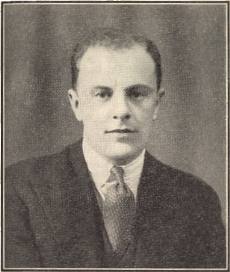
Reginald Charles Noel-Johnson (pictured on the left) had an interesting story to tell. Let’s find out more.
We’ll start with his father, (William) Noel Johnson (no hyphen: that came later), a cellist, conductor and composer. Here’s how he was described in Brown & Stratton’s British Musical Biography (1897). 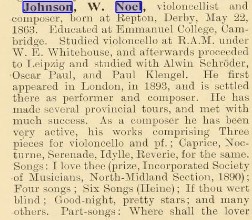
 Again, from two years later:
Again, from two years later: 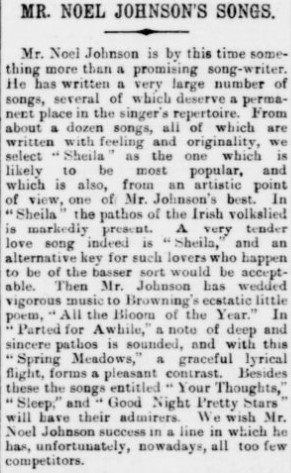 Here we have a successful composer of music mostly for home consumption: songs, short pieces for cello and piano and so on. Music which, perhaps sadly, has now gone out of fashion: I haven’t been able to find any recordings of these songs, but a later work, comprising three short piano pieces, has been recorded for YouTube by Phillip Sear, a specialist in this type of repertoire.
Here we have a successful composer of music mostly for home consumption: songs, short pieces for cello and piano and so on. Music which, perhaps sadly, has now gone out of fashion: I haven’t been able to find any recordings of these songs, but a later work, comprising three short piano pieces, has been recorded for YouTube by Phillip Sear, a specialist in this type of repertoire.
Pleasant enough, I suppose, but they rather remind me of the pieces I was expected to practise when I was learning the piano many years ago. Hardly imaginative or profound but they served their purpose at the time.
Between the songs and the piano pieces, in 1902, Noel married Rosina (Rosie) Johnson, twenty years his junior and not related in spite of the shared surname, with four children being born in London: Reginald (1904), Kathleen (1906), Eric (1907) and (William) Brian (1908). The family then moved to Whitstable, Kent, where two further sons were born, Dennis (1913) and (George) Douglas (1915).
Many years later, in 1975, Kathleen would look back fondly on their time there. 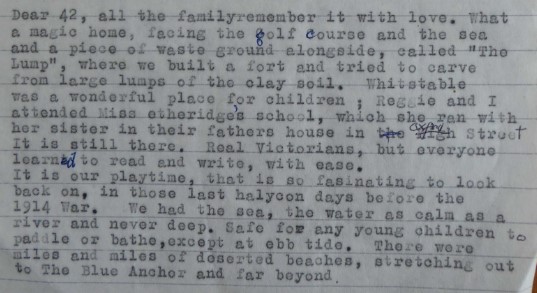 But the family’s idyllic seaside life was shattered in January 1916 when William Noel Johnson, now living near Southend, died suddenly of pneumonia, leaving Rosie a widow with six young children.
But the family’s idyllic seaside life was shattered in January 1916 when William Noel Johnson, now living near Southend, died suddenly of pneumonia, leaving Rosie a widow with six young children.
In the words of his last song, “Rosemary, that’s for remembrance”.
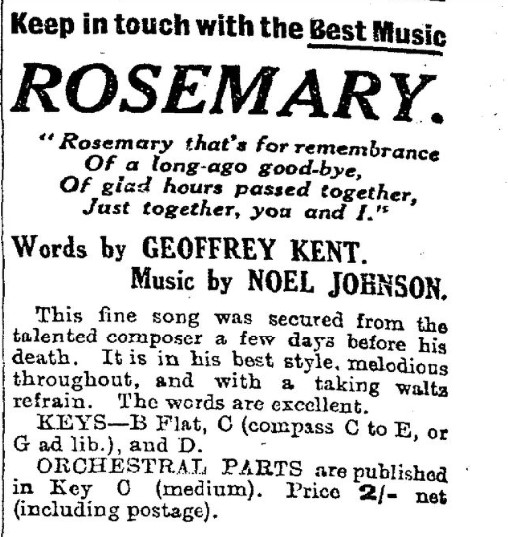
It can’t have been easy for Rosina, and it appears that the family also had financial problems.
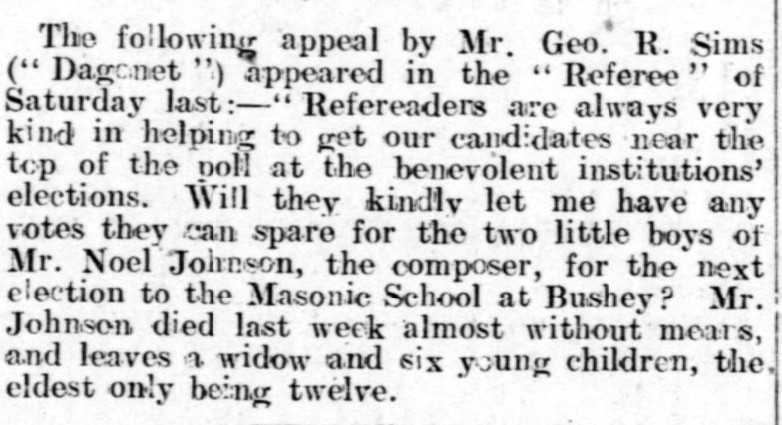
The 1921 census found them, now having changed their surname to Noel-Johnson, perhaps to honour their late father, split up.
Rosie and Reggie, perhaps he’d just left the Masonic School, were living in a boarding house in South Kensington. Rosie had found work as a secretary, while her eldest son, following in his father’s footsteps, had an apprenticeship at Chappell’s, the music publishers, who had published some of Noel’s compositions.
Eric was at a boarding school on Clapham Common, just a few doors away from what is now Ray Keene’s residence. Kathleen, Brian and Douglas were ‘inmates’ at the Actors’ Orphanage in Langley, Buckinghamshire. Dennis had been adopted by a childless couple, Henry and Ethel Cullum (were they family friends?) and had taken on their surname.
It appears that, very soon afterwards, Reginald moved to somewhere in South or South East London, taking up chess at the same time. The first reference I can find is in February 1922, just a few days before his 18th birthday, playing on Board 13 in a county match between Kent and Essex. He must have gained rapid recognition as a pretty useful player. He seems to have been the only competitive chess player in his family so perhaps he learnt at school.
The following year he played on top board for a Men of Kent team in a friendly match against a Ladies’ Team, drawing his game against Miss Edith Charlotte Price. The Men of Kent were west of the River Medway, while the Kentish men were on the east.
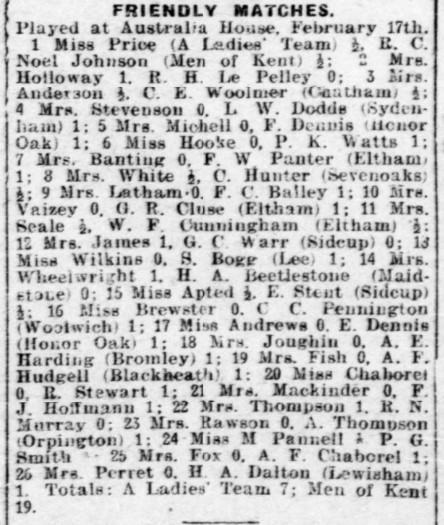
In 1924 Noel-Johnson took part in his first public tournament, travelling to Weston-super-Mare for the West of England Championships where he was placed in the Second Class Section A tournament. This proved a great success, his score of 8½/9 demonstrated that he was already much more than a second class player. He also finished in second place in a Quick Play Tournament: clearly a young, ambitious and improving player.
The county selectors eventually noticed this and promoted him to one of the top boards in the county team.
He didn’t have far to go for his next tournament, the Kent County Championship held in Bromley in April 1925. The format of the top section was interesting: four sections each including six amateurs and two visiting European masters.
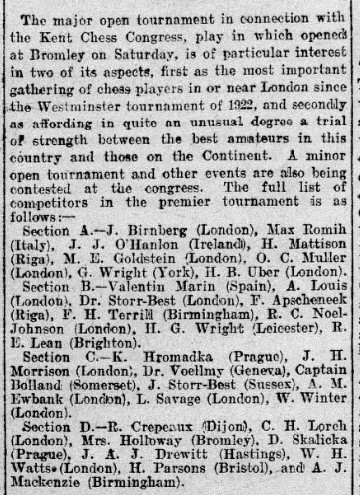
In the first round Reginald attracted considerable attention for the hard fight he put up against his Latvian opponent (retrospectively rated 2386 in 1925 by Rod Edwards.
He had a strong attack for the pawn early on and, much later, came close to drawing the ending.
He finished on 3/7, an excellent score for someone with so little experience at that level.
The four section winners entered the final pool, with the remaining competitors playing three more rounds using the Swiss System to determine six further prize-winners. You’ll see that he won all three of these games.
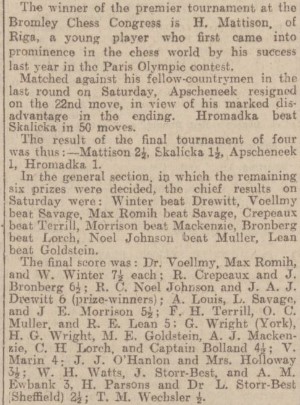
Later in the year, he had a county match game published in the British Chess Magazine. His opponent’s name is remembered today through the Wernick Cup, awarded since 1922 to the winner of the fourth division of the Surrey individual championship. Jack Redon, who will be the subject of a future Minor Piece, won it in 1923, as did a certain RD Keene in 1962.
It would be some years, though, before he played another public tournament, but he remained very active in club and county chess, winning the county championship for the first time in 1927, and again in 1931 and 1932.
Here’s a position for adjudication from the decisive game of a 1931 county match: Noel-Johnson was white against John Harold Morrison of Middlesex.
The players and spectators thought Black was winning but Yates gave White a win on adjudication.
White has two ways to win.
1. Rxc8 b3 (1… Rxc8 2. Bxc8 b3 3. Ba6 bxa2 (3… b2 4. Bd3) 4. Bc4+) 2. Rxb8 bxa2 3. Be6+! Kxe6 4. Re8+
or, perhaps more simply,
1. c6 b3 2. c7 Rb6 3. Rxc8 bxa2 4. Rf8+!
Although his main club was Lewisham, Reginald also played for Clapham Common, where his brother Eric had attended school.
Here he is, facing Richmond & Kew in an Alexander Cup (Surrey KO) match.
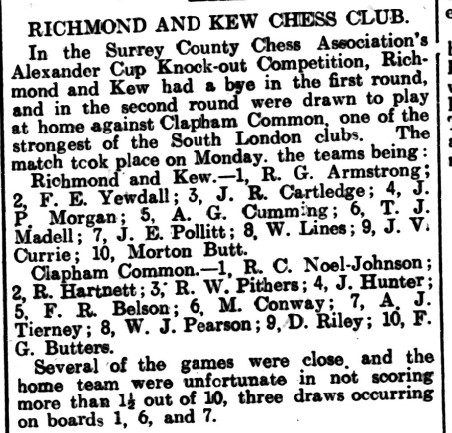
By the summer of 1933 he had time to take in another public tournament, travelling down to Hastings for the British Championships. He played in the Premier Reserves, in effect the third division, and, as you’ll see, finished a point clear of the field, drawing his first encounter with Alfred Lenton along the way.
In 1935 he won his fourth county title, defeating Walter Yeeles in the final. Here are the two games: he was close to winning in the first, but made no mistake in the second.
1936 saw his only British Championship appearance, which you read about at the start of this article.
This was also the year when his club, Lewisham, won the London League for the first time (they’d repeat their success the following year). Noel-Johnson arranged a presentation to the match captain, in the presence of two world champions.
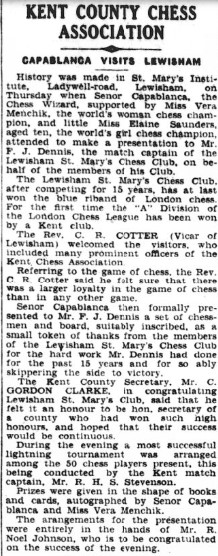
In 1937, as well as taking the Kent title again (just as two years earlier, winning the second game against Yeeles after a draw) he took part in a small semi-international tournament to celebrate the centenary of Worcester Chess Club, finishing on 50%. At this point Rod Edwards on EdoChess gives him a retrospective rating of 2165.
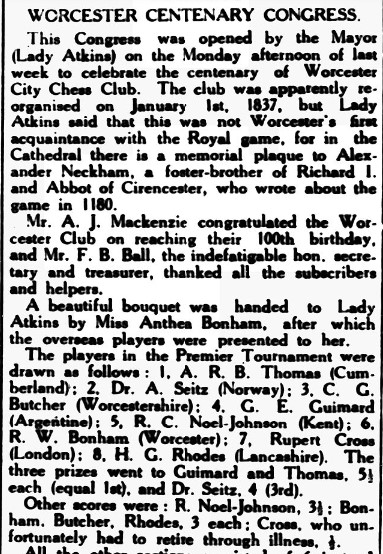
In 1938 Reginald took part in a simul against Alekhine at the Charing Cross Hotel. He’s pictured here at the left, alongside Elaine Saunders, C Chapman, HH Cole, H Israel and Walter Yeeles.
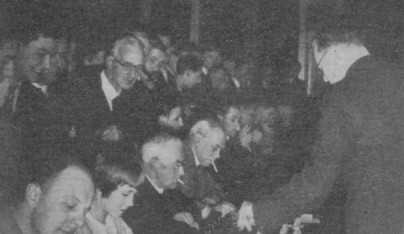
In the final of the 1938 Kent Championship, Noel-Johnson had the opportunity for a classic double bishop sacrifice, calculating accurately right to the end to give his opponent no chance.
Francis Tims Collins would later join the RAF Volunteer Reserve, and was tragically killed on the evening of the 27th of November 1943, when the RAF Lancaster in which he was a navigator was shot down over Heuchelheim, Germany.
In November 1938 a weekend tournament was held in Bournemouth, with the players divided into groups of four. This would be called a quad tournament in the USA: I’ve often wondered why this format (extensively used at Richmond Junior Club for many years) has never taken off over here. The top two sections each featured four county champions, Noel-Johnson winning his section with 2½/3 against the champions of Devon, Hampshire and Essex.
As county champion again, he played on top board in this county match against Surrey, who fielded the confusingly named but unrelated Laurie Alexander and Frederick Forrest Lawrie Alexander on the top two boards.
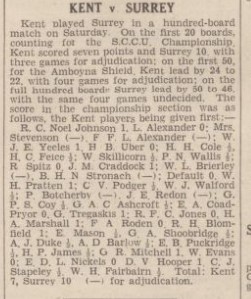
Here’s his game, a pretty clear-cut win.
Noel-Johnson encountered young Elaine Saunders again in a living chess display in Croydon later in 1939.
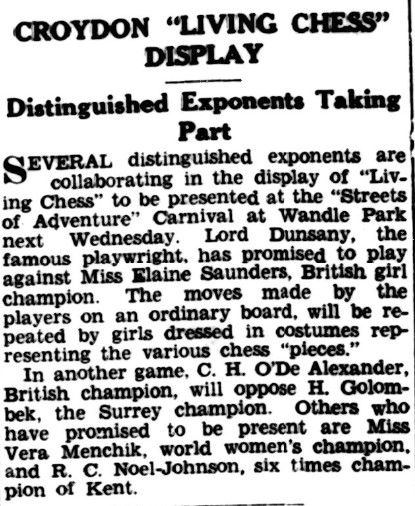
Later that month, a match between Metropolitan Kent and West/Mid Kent resulted in an exciting finish. At the close of play the score was 25-24 in favour of the Mets, with just the top board, between Noel-Johnson and the long-lived Philip Coy, for adjudication.
The result was a win for Reginald, making the score 26-24.
But then the Second World War intervened and Noel-Johnson’s chess career was mostly on hold, although he did take part in a tournament at the National Chess Centre in 1940. Here, players were grouped by the first letter of their surname, and he won the Rare Letters section ahead of Harold Israel.
In the fourth quarter of 1940 Reginald Charles Noel-Johnson married American born Jane Ann Richards in Kensington. And on 22 November that year he was appointed Pilot Officer in the Administrative and Special Duties branch of the RAF for the duration of hostilities.
His life had changed. He was no longer a bachelor working in music publishing and playing chess in his spare time, but a married man serving in the armed forces. You’ll find out what happened next in part 2 of Reginald’s story.
Sources & Acknowledgements:
ancestry.co.uk (family trees of Clive Noel-Johnson and Sally (Noel-Johnson) Giddings)
findmypast.co.uk/British Newspaper Library
Forces War Records
YouTube/Phillip Sear
Wikipedia
BritBase (John Saunders – thanks also for his RCNJ games collection)
chessgames.com
British Chess Magazine
EdoChess (Rod Edwards)
ChessBase/Stockfish 16

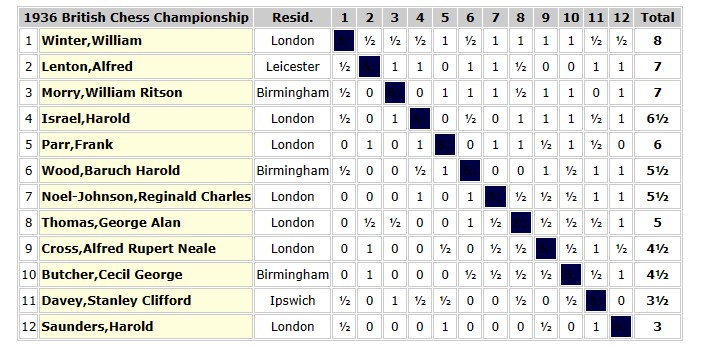
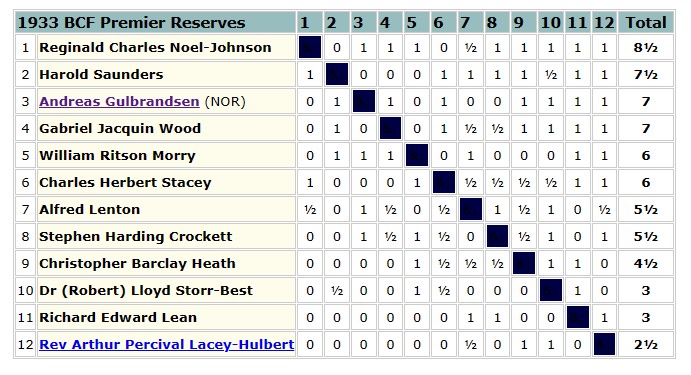
“with the players divided into groups of four. This would be called a quad tournament in the USA”…
This is a common occurrence in the Netherlands, especially alongside the standard tournament groups for weekends. The groups of 4 ( “vierkampen”) are usually with 4 players of approximately the same rating and generally one game a day., so enjoyable and equalish chess, plus it takes up only an afternoon.
It is used in League chess as well at times, for club members/teams that do not participate in the full league.
Thanks.